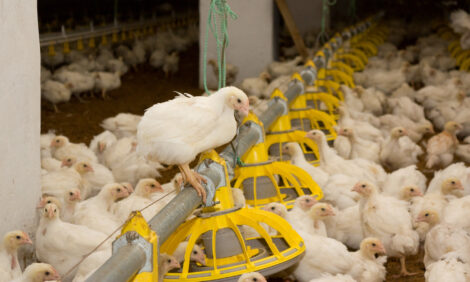



Studies on Newly Emerging Reassortant Very Virulent Infectious Bursal Disease Viruses
Current breeder vaccination programmes may not adequately protect birds against the more recent very virulent strains of infectious bursal disease virus (IBDV), concludes an Ohio State University researcher from a new study.In December 2008, the first very virulent (vv) IBDV was isolated in California, and in 2009, the reassorted viruses, K785 and D495 were identified, according to Dr Daral J. Jackwood of Ohio State University. Genome segment A of these reassortants was typical of vvIBDV but genome segment B was most closely related to serotype 2 IBDV (A/B = vv/serotype 2).
Since that time, he and his group have identified several genome reassorted viruses that represent combinations of genome segments from vv, classic virulent (cv) and serotype 2 IBDV.
The problem is, he states, that we know very little about the virulence of these newly emerging reassorted viruses for chickens and turkeys.
His project, sponsored by US Poultry and Egg Association, had two objectives:
- The ability of three reassorted vvIBDV from California to infect and cause disease in chickens and turkeys will be determined.
- The ability of anti-IBDV maternal immunity to block infection and disease of pathogenic reassorted viruses will be determined in chickens.
Objectives 1 and 2 were expanded to include more than three IBDV strains. All the viruses were isolated from California. The K669, D495 and K785 viruses are interserotypic vv/serotype 2 reassortants. The D2712 (serotype 2/cv) virus was isolated from commercial turkeys in January 2012. The 7741 strain is a vv/cv reassortant. It was identified in commercial layers in August 2010 and its genome segment B aligned with cvIBDV strains from Argentina and Australia. The cv/vv reassorted virus D6337 was isolated in 2012 from a backyard chicken flock. A non-reassorted turkey isolate, T3599 (serotype2/serotype 2) was isolated in 2013 from the small intestine by Dr P. Woolcock (CAHFS) and was included in this study, because it was a recent isolate from a region where the vv/serotype 2 viruses were discovered.
To meet the first objective, in-vivo virulence of reassortant IBDV was assessed relative to the virulence of other IBDV pathotypes: vvIBDV (rB strain), classic virulent (cv) (STC strain) and subclinical variant (sc) (Del E strain).
Morbidity and mortality in four-week-old Specific Pathogen Free (SPF) Leghorns indicated that reassortant IBDV with a vv genome segment A and non-vv segment B were less pathogenic than the vv/vv rB strain but more pathogenic than the cv/cv STC strain. The cv/vv IBDV strain D6337 was comparable to the STC strain in pathogenicity.
Viruses with a serotype 2 genome segment A, regardless of the type of genome segment B, did not cause clinical disease in SPF chickens or turkeys. Reassorted viruses did not cause morbidity, mortality or gross lesions in SPF turkeys. Histopathologic lesions in the bursa of turkeys were not observed in any group except OH, which had a mild lymphocytic depletion.
On objective 2, no mortality was observed in maternally immune broilers inoculated with any of the IBDV pathotypes at one, two, three and four weeks of age. No bursal lesions were observed in any of the experimental groups at one week of age except for the D2712-inoculated birds that had mild lymphocyte depletion.
In broilers challenged at two weeks of age, the K669 virus broke through the maternal immunity while the STC, Del-E, rB, D2712 and 7741 viruses did not. All viruses broke through maternal immunity at three weeks of age except the Del-E and D2712 viruses. At four weeks of age, maternal antibodies were very low, and bursal lesions were observed in all broilers challenged with these viruses.
On the impact of the results, Dr Jackwood commented that genome reassorted IBDV appear to be less pathogenic than vvIBDV. However, these viruses can still cause morbidity and mortality in SPF chickens, and they were able to break through maternal immunity produced using commercial classic and variant vaccines.
He added that this suggests current breeder vaccination programmes may not adequately protect against the reassorted vv/serotype 2 and vv/cv IBDV strains.
Further Reading
Find out more information on Infectious Bursal Disease (IBD; Gumboro disease) by clicking here.
February 2014








